It’s that time of year again, that predictable bout of escapism when we start thinking about our next cold weather holidays. Today (as with every day, quite honestly), our thoughts have turned to Austria and, specifically, its food, because like so many we associate strudel and schnitzel with snowflakes, which for us means a holiday in the snow!
Known for its hearty cuisine full of stews, soups and some of the world’s best sweet treats, you’d be forgiven for thinking that Austrian food is a little heavy. That, my hungry friends, is a stereotype that doesn’t reflect the true diversity and quality of Austrian cuisine.
Take its famous Tafelspitz, a boiled beef soup. Here in the UK, boiled beef means cheap cuts of meat that are cooked to make them tender and edible. When it comes to an Austrian Tafelspitz, however, only the finest cut is used (more on this it later). Or even Apfelstrudel, Austria’s signature pastry, which requires some serious tekkers to make. Quite simple, it’s a dish that deserved respect.
Many mistake its heartiness and richness for a lack of sophistication or finesse, but while Austrian food may be simple, unpretentious and the opposite of fancy, it’s an artful cuisine that will warm you up on both the inside and outside. It will fill you up and make you happy. With this in mind, if you’re planning to visit Austria, here are 19 must-try dishes for a real, no-nonsense taste of Austrian culture.
Wiener Schnitzel
The iconic breaded and fried veal cutlet…
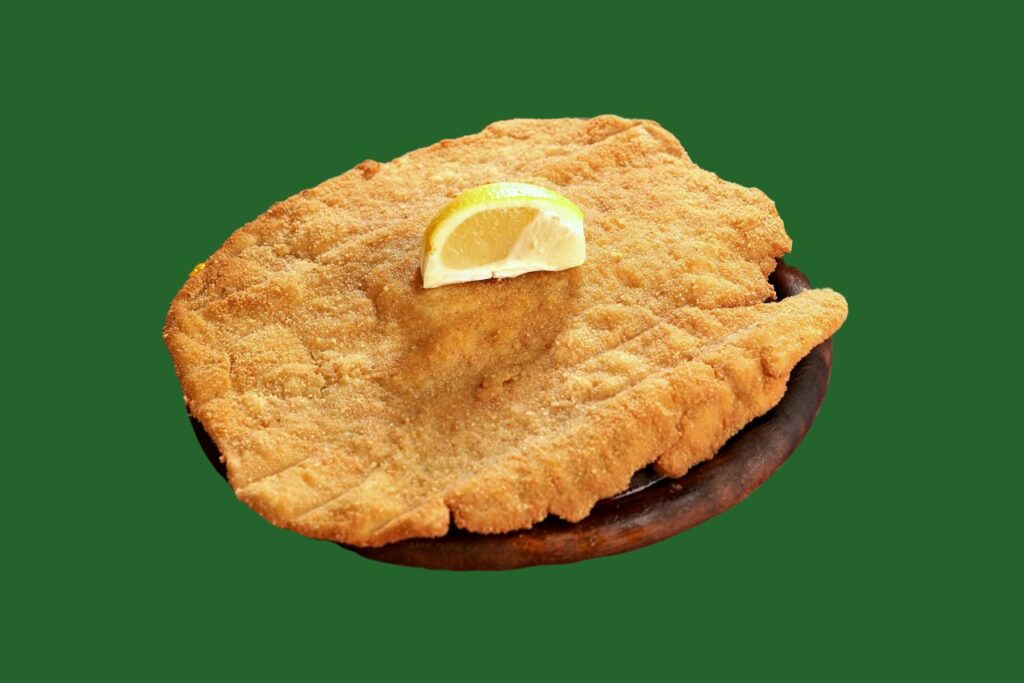
Arguably Austria’s most famous culinary export, the Wiener Schnitzel is a simple dish but when done well, it’s also one of the most satisfying in the world – fried food often is, don’t you think? – especially when it offers a ruddy crunch that is deserving of an ASMR video.
A true Wiener Schnitzel should be large – in fact, it should be so big that it overlaps the edges of the plate. That’s exactly how they are at Figlmüller in Vienna where you should head to try this dish. They are renowned for their oversized schnitzels served simply, prosaically with a wedge of lemon. Though variations exist, the original Wiener Schnitzel is always made from veal. That said, Figlmüller cater to all tastes and have both pork and veal on the menu.
Be warned; a lot of tourists seek out Figlmüller and there will be a queue, but it’s worth the wait. Why, you ask? Well, here the meat is pounded to an optimal thinness so it’s tender and cooks evenly. It’s well-seasoned and breaded so the breadcrumbs cling to the meat like a jacket, and then fried until the surface has a glorious golden brown hue, slightly shimmering with butter for that coveted crispy crust. That, and they are huge. Order some lingonberry preserve and a medley of sides – a potato salad is obligatory – and you’ll be a very full, very happy person.
Read: 6 ideal things to do in Vienna
Apfelstrudel
Austria’s signature pastry….
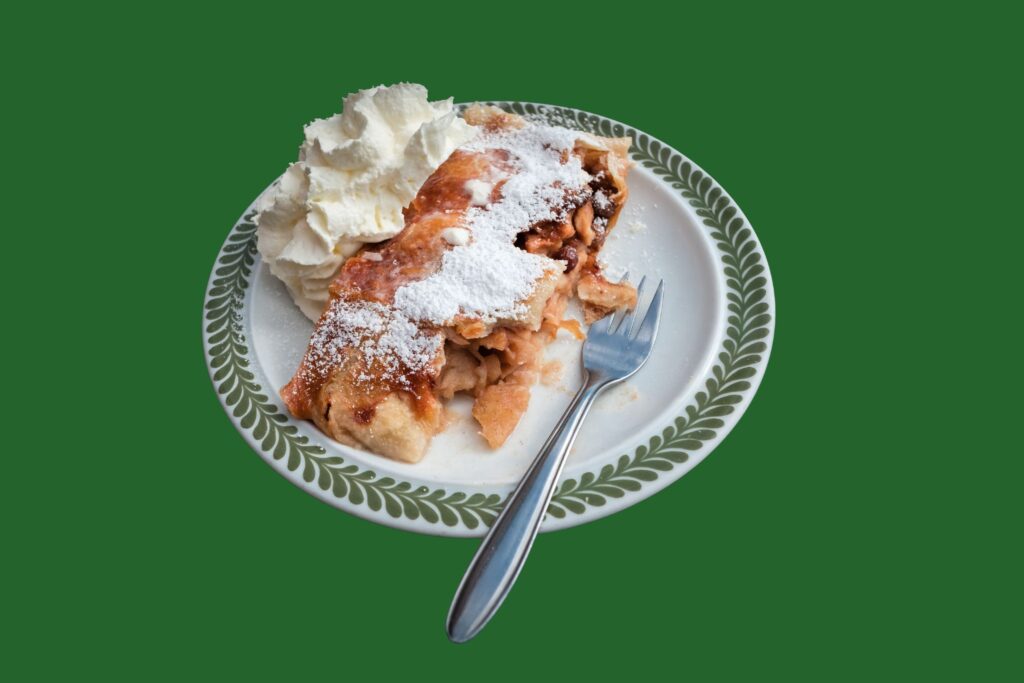
Apfelstrudel, Austria’s signature pastry, is a delightful mingle of delicate, flaky layers, encasing a luscious apple-cinnamon filling. The art of its making is steeped in tradition, and is more a work of art than a piece of cooking. It’s a culinary spectacle worthy of the Austrians’ pride.
Go and watch it be made at Café Residenz, another one of Vienna’s time-worn cafés, which is located within the historic Schönbrunn Palace. In the show-baking parlour you can witness master pastry chefs hand-pulling the pastry, which is rolled so thin you could read a newspaper through it, making for a feather-light Apfelstrudel. Heaven!
Read: Exploring Central Europe by high-speed train
Brettljause
The ideal Austrian snack board…
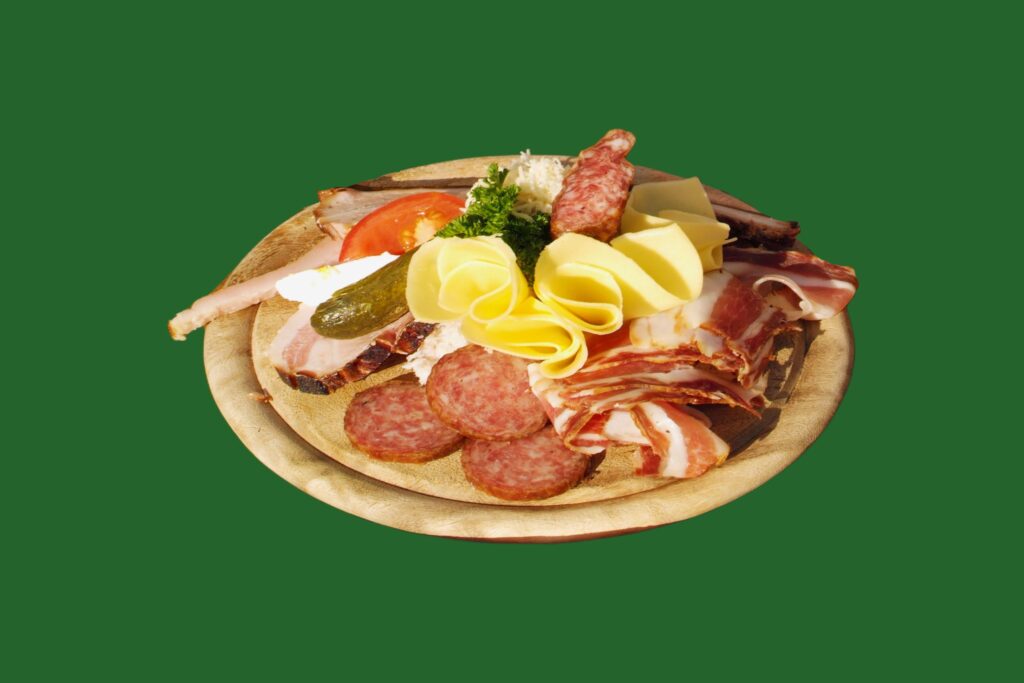
“What do you crave after a morning of energetic hiking or skiing in the Alps?”, asks the tourism site Austria Info. Well, apparently “lots of flavourful cured meats, fragrant cheeses, and a rustic dark bread to go along with it” does the job pretty spectacularly. We couldn’t agree more!
Known as Brettljause, which literally translates as “snack on a board”, it’s a popular choice for a leisurely, rustic lunch and is typically served in inns, vineyards and mountain huts.
Try Brettljause at Sennhütte in St. Anton am Arlberg, ideally coupled with a walking holiday in Austria. Look out for verions that feature Tirolean speck, a cured ham seasoned with a mix of spices like juniper, garlic, salt and pepper, before being smoked and matured for several months – it’s a staple of any decent Brettljause in the Arlberg region. If you’re not going on a hiking holiday, Heuriger Wieninger in Vienna offers a splendid rendition..
Tafelspitz
Boiled beef done right…

Beef boiled in broth served with apple and horseradish may not sound like the most enticing dish, but it’s actually considered a supremely refined affair, traditionally reserved for royalty and much loved by Emperor Franz Joseph. And honestly, we can see why!
Always comforting and reviving to sit down to some boiled meat, Tafelspit is a rarity in that the dish only makes use of the very finest cuts of beef. The accompanying apple and horseradish mixture served alongside this Viennese dish offers a tangy, spicy counterpoint to the beef’s mellow taste, all resulting in a harmonious plate. As New York-based Austrian celebrity chef Kurt Gutenbrunner describes tafelspitz, it’s “a dish with a lot going on: it’s hot, cold, spicy, creamy, crunchy and soft”.
He’s spot on.
One of the best places to try Tafelspitz is at Plachutta, a temple of Viennese cuisine. Here, the room is always packed and people of all types rub shoulders, resulting in a convivial ambience that’s just as warming as the beef stew in front of you.
Read: 7 Of Europe’s best cycling routes for an adventure holiday
Sachertorte
A deceptively simple, delicious chocolate cake with apricot filling…

Have you really been to Austria if you haven’t had a slice of Sachertorte, arguably the world’s most famous chocolate cake?
Decadent and delightful, this cake has a deep, intense chocolate flavour that’s not too sweet. Its thin layer of apricot jam adds contrast to the rich chocolate, bringing a subtle sweetness and slight tartness.
The iconic Café Sacher in Vienna, which is the original home of this dessert, is the place to try this dish – a version in which you can nearly see yourself owing to its glossy icing. That said, there are several other belters in the city; Demel, Hotel Imperial, Café Mozart and Café Central all do excellent versions.
Ideal tip: If you ever get a chance to try an Austrian apricot, do it! Several varieties of apricot are grown only in the Wachau Valley in Austria, which is approximately 40 miles northwest of Vienna. Bring us back some jam while you’re at it, please.
Kaiserschmarrn
Sweet shredded pancakes that are ideal for breakfast or tea…
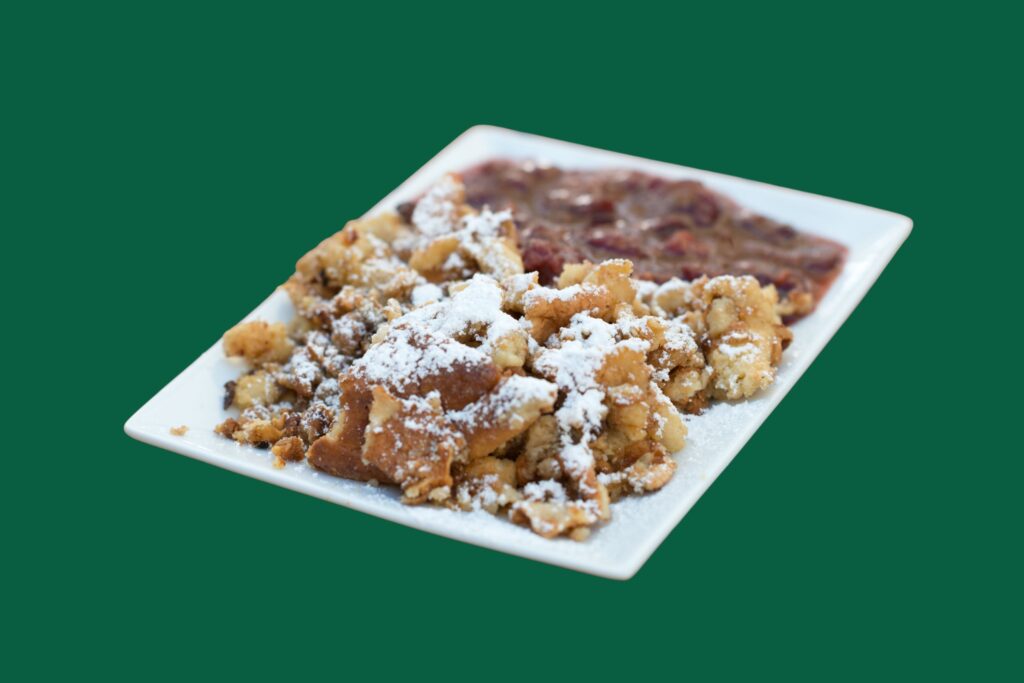
You’ll be pleased to hear that Austrians like to add a second breakfast to their day; gabelfrühstück, or ‘fork breakfast’. This isn’t like a typical breakfast, but more of a snack that often includes bread, sausages, or cheeses. They also like a good ‘jause’ before tea, which is a light, cold meal generally eaten between breakfast and lunch, or in the afternoon. That’s plenty of eating slots and time for you to try lots of different dishes.
Indeed, Austria isn’t a country in a hurry, which means there’s time to order plenty, and linger over a loaded lunch in one of their famous, untouched-by-time coffee houses of which so much of the culture is built around. Get yourself installed in one and order a round of Kaiserschmarrn…
Essentially a pancake topped with fruit, Kaiserschmarrn is one for the sweet toothed. This regal dish, whose moniker translates to ‘Emperor’s Mess’, is a light, caramelised pancake, torn into bite-sized pieces, generously dusted with powdered sugar, and often accompanied by a tart plum or apple compote.
The story goes that imperfect pancakes were rejected by the Austrian Emperor Franz Joseph and the rejects went to his servants, (we know what we’re making for pancake day when ours go wrong now!).
Steirereck, nestled in a verdant corner of Vienna’s Stadtpark is the ideal place to try it. Here, the fluffy texture of the pancakes is perfectly balanced with a slight crisp from caramelisation, and the accompanying seasonal fruit compote adds just the right amount of acidity.
Marillenknödel
Apricot dumplings…

And onto yet another sweet treat; Marillenknödel! These apricot dumplings are a cherished snack, especially in Lower Austria where they originated. Made by enclosing a fresh apricot in a dough made from potato or cheese, these sweet dumplings are then boiled, rolled in breadcrumbs and sugar, and served with powdered sugar on top.
Mostbaron Schriebl, a family-run restaurant in Lower Austria, is renowned for its authentic Marillenknödel. Using ripe apricots from their own orchards and following traditional recipes, they offer a genuine taste of Austria.
Linzer Torte
A jam-filled, lattice-topped pastry…
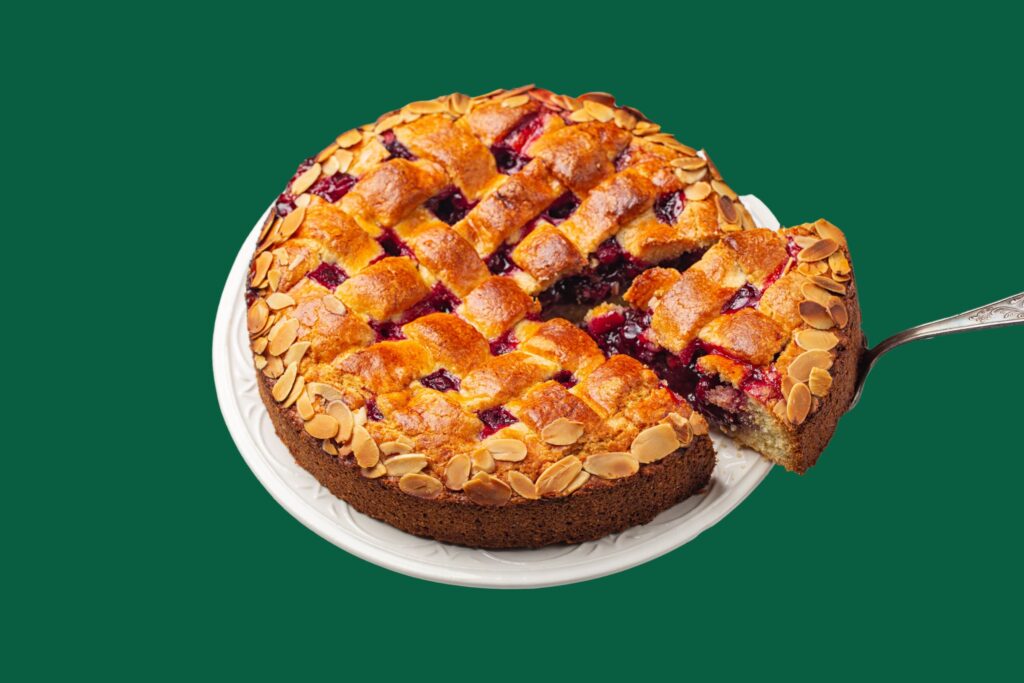
Linzer Torte is one of the oldest known cakes in the world, with recipes dating back to 1653. With a name derived from the city of Linz, it’s a layered pastry with a lattice design on top and filled with jam, typically blackcurrant or red currant. The crust is made of flour, ground nuts (usually almonds, but can also be hazelnuts or walnuts), sugar, egg yolks, spices (like cinnamon and cloves), and lemon zest. The lattice design is an iconic aspect of this dessert, making it instantly recognisable to hungry punters entering one of Austria’s many, many bakeries.
K.u.K. Hofbäckerei Café in Linz is one of the most country’s most famed places to serve Linzer Torte. In fact, K.u.K. stands for ‘kaiserlich und königlich’, meaning ‘imperial and royal’ in English and indicating that the bakery was once a supplier to the Austrian imperial court. This venerable establishment has been crafting pastries since 1829 and is particularly known for its authentic, traditional Linzer Torte.
Powidl Liwanzen
Small yeast pancakes with plum jam, ideal with coffee…
Powidl Liwanzen are essentially small pancakes or dumplings filled with Powidl, a type of prune jam made without added sugar. Often served sprinkled with powdered sugar, these guys pair beautifully with a good cup of coffee. Cafe Central in Vienna does a particularly exemplary version.
Rindsuppe
A clear beef soup…
Known as the national soup of Austria, Rindsuppe is a culinary gem and a cornerstone of Austrian cuisine. The clear beef broth, light and bursting with flavour, is served with various accoutrements like Frittaten (sliced pancakes), Leberknödel (liver dumplings) and Schöberl (a type of crouton). Try it at Gasthaus Pöschl, Vienna, for an old-world dining atmosphere. An iconic dish presented in an iconic setting… What’s not to love?
Zwiebelrostbraten
Roast beef topped with crispy onions…
Tender and juicy beef topped with crispy fried onions and served with roast potatoes or dumplings? Yes please!
Gasthaus Zur Goldenen Glocke in Graz, Austria, is renowned for its delicious, authentically prepared Zwiebelrostbraten. Here, the dish is made with locally-sourced ingredients and follows traditional cooking techniques, ensuring the beef is incredibly tender and the onions perfectly caramelised. The sauce, a secret family recipe, adds an exceptional depth of flavour.
Salzburger Nockerl
A triple-mounded sweet soufflé from Salzburg…
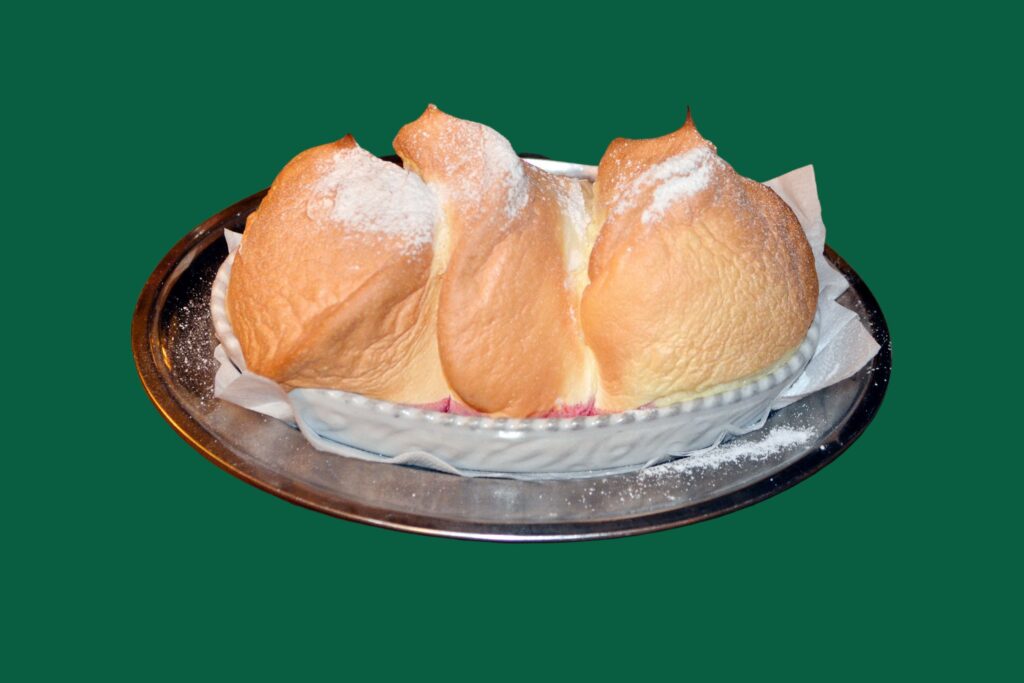
This dessert, the crowd pleasing Salzburger Nockerl, is light, fluffy, and delicate, and is often served with a side of berry sauce for an added tangy complement to the dish’s inherent sweetness. The three peaks of the dessert are said to represent the hills surrounding Salzburg, and Café Tomaselli in the city is a great place to try this dish.
Beuschel
A ragout made with lungs and heart…
Beuschel, a traditional dish originating from Vienna, is a ragout made most commondly from the lungs and heart of a calf, though other parts like the spleen and liver might also be used.
The meat is cut into strips and simmered in a tangy, sour sauce made from root vegetables, vinegar, and white wine. The dish is then finished with a generous splodge of sour cream, adding a creaminess that balances acidic, piquant notes of the braising liquour. This one is usually served with bread dumplings (Semmelknödel) to soak up the sauce. Yum.
Gasthaus Ubl, located in the fourth district of Vienna, is renowned for its authentic and delicious rendition of Beuschel. Indeed, a major part of the experience of eating Beuschel is enjoying it in a traditionally cosy, warm Viennese setting, which Gasthaus Ubl provides by the bucketloads.
Goulash
A hearty stew of meat and vegetables, seasoned with paprika…
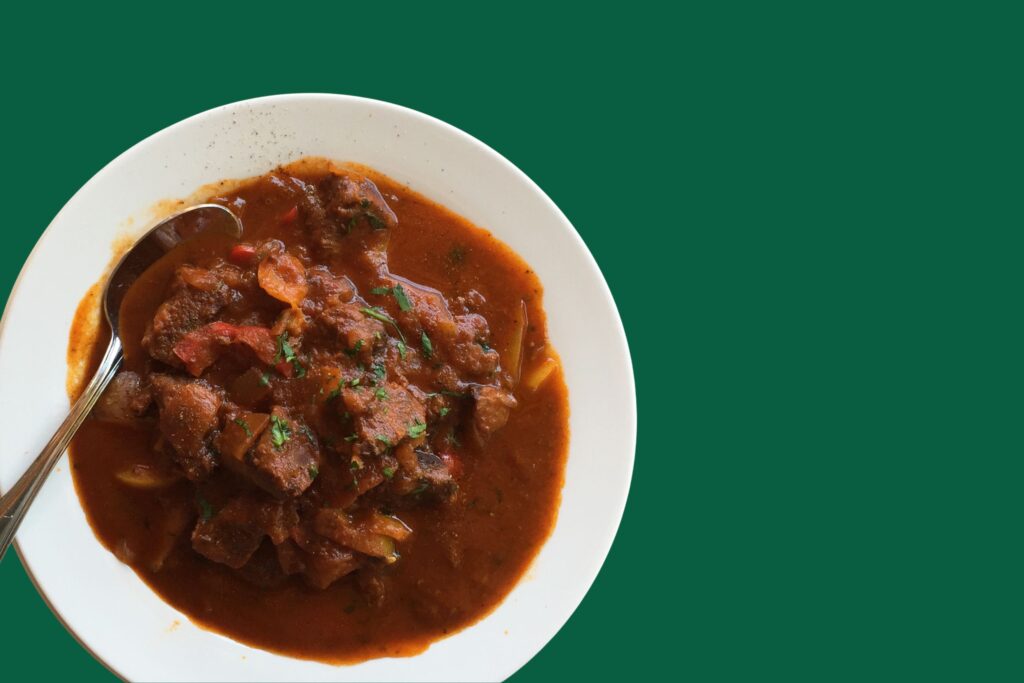
A winter warmer if ever there was one! Originating in Hungary, the people of Austria love Goulash so much that they have their own version. The secret here is to use lots of onions, and you can tell the difference between the two countries because of this one ingredient, as Austrian goulash contains only beef and onions whereas Hungarian goulash often includes vegetables like potatoes, carrots, celery, peppers, and tomatoes, too.
In Austria, goulash is often served with bread dumplings which are wonderful vehicles for soaking up the sauce leftover from the stew. Whilst you’ll find Goulash all over the country, Vienna’s Ilona Stuberl does a darn fine interpretation of this classic.
Erdäpfelsalat
Austrian potato salad…
You say ‘potato’, Austrians say ‘Erdäpfel’. Add the ‘salat’ part and you’ve got yourself an Austrian potato salad, a much breezier thing than the mayonnaise-led American version.
An Austrian potato salad is lighter; flavoured with onions, vinegar, and mustard. Try it at Vienna’s Figlmüller alongside that schnitzel we mentioned earlier.
Leberknödelsuppe
Liver dumpling soup…

There is very rarely a middle ground with liver. You either love it or you hate it. If you fall into the former camp then you’ll love this traditional Austrian soup. The main ingredient, as the name suggests, is a dumpling made from liver, usually pig’s or cow’s. Though the dumplings have a distinct grey colour, don’t let that put you off; they are delicious.
Enjoy a bowl at Gasthaus Rebhuhn in Vienna – an eatery well-loved by locals. Their Leberknödelsuppe is widely praised for its rich flavour and perfect, bouncy texture.
Vanillekipferl
Vanilla flavoured biscuits…

One to take home for a souvenir, especially if you’re visiting Austria’s Christmas markets, Vanillekipferl are traditional Austrian cookies that are particularly popular during the festive season. Boasting a distinct crescent or half-moon shape, they are just perfect with a mug of something steaming.
Café Demel, known as one of Vienna’s most historic coffee houses, is famous for its pastries, including Vanillekipferl. That, or hit up the Vienna Christmas Market on Rathausplatz for superb Vanillekipferl.
Mozartkugel
Chocolate balls filled with marzipan and nougat...
Mozartkugel, or Mozart Balls, are a sweet treat if ever there was one. They are named after the famous composer Wolfgang Amadeus Mozart and are a popular souvenir, especially in Salzburg, Mozart’s birthplace. The chocolate treat is a small, round candy made of pistachio marzipan and nougat, covered with dark chocolate, and at many places, the original recipe hasn’t changed since it was first created in 1890 by the Salzburg confectioner, Paul Fürst.
Café-Konditorei Fürst in Salzburg, the original creators of Mozartkugel, is of course the best place to try these. Here, the chocolates are still hand-made using the original recipe, and are wrapped in silver foil with a blue ribbon to distinguish it from other manufacturers’ versions, as it always has been.
A Glass of Schnapps
The ideal way to end things…
We know, this isn’t a dish, but how could we write a list of things to try in Austria without ending, like all meals in the country should, with a glass of schnapps? A cliche, yes, but necessary after all this feasting. Prost to that!





